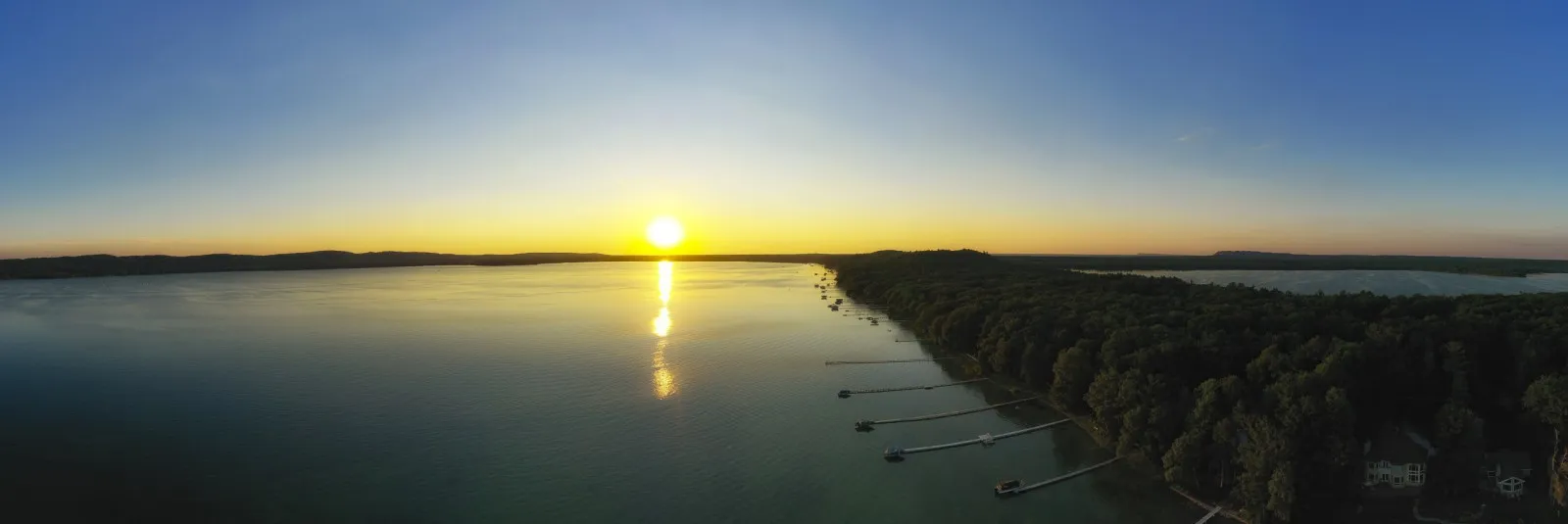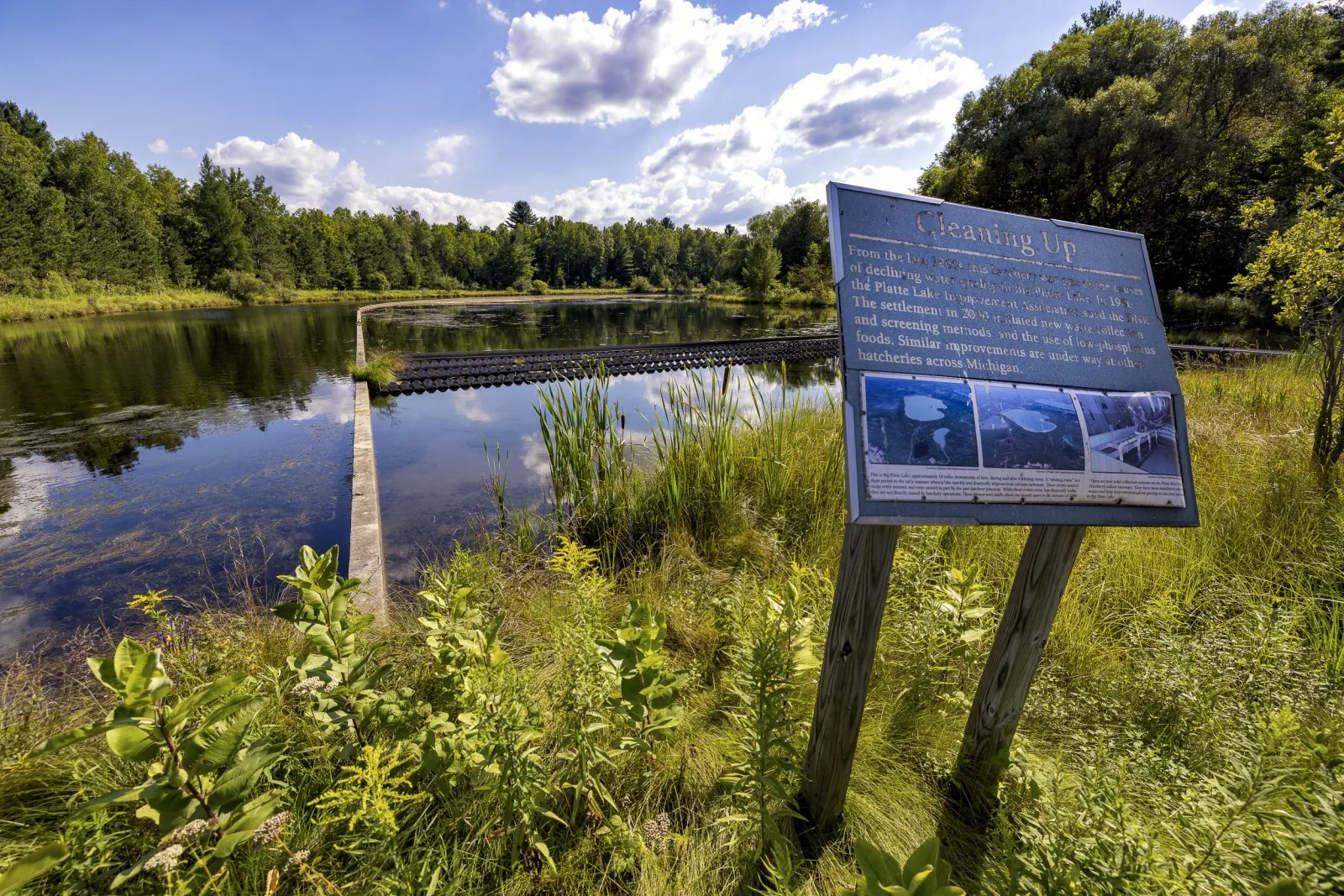
By Keith Schneider, Circle of Blue
The Great Lakes News Collaborative includes Bridge Michigan; Circle of Blue; Great Lakes Now at Detroit Public Television; and Michigan Radio, Michigan’s NPR News Leader; who work together to bring audiences news and information about the impact of climate change, pollution, and aging infrastructure on the Great Lakes and drinking water. This independent journalism is supported by the Charles Stewart Mott Foundation. Find all the work HERE.
Sixth in a six-part series. Read the first story here.
HONOR, Mich. – In 1974, when he was 27 years old, Wilfred Swiecki invited his Maltese-born fiancée to join him at the family cottage on Platte Lake in Benzie County. Though he’d been away for several years pursuing degrees in engineering, Swiecki anticipated showing her the same magnificent northern Michigan lake of his boyhood summers — waters teeming with bass and pike and so clear the deep lake bottom was plainly visible.
Swiecki’s return was a shock. Lake waters were green and filmy with algae. Swirls of blue-green algae and ugly algae mats floated on the surface. The air carried the scent of decay. “I couldn’t see my toes in three feet of water,” Swiecki recalled in an interview. “I said, ‘This is crazy.’ So I really got into it.”
With the help of other members of Platte Lake Improvement Association, plus a team of lawyers and scientists, Swiecki led a 48-year campaign that forced a state fish hatchery to sharply reduce its bloom-generating phosphorus discharges, an achievement that set enduring precedents in state environmental law, and restored the lake’s ecological condition. The association also built a state-of-the art water quality monitoring network across the lake’s 192 square-mile watershed. Its data, available online, provide real-time evidence to identify and squelch sources of phosphorus that would impair water quality.
In its simplest explanation, what occurred in this corner of northwest Michigan, some 300 miles from Lake Erie, is that Platte Lake’s citizen activists refused to be deterred. They relied on a lawsuit, peerless science, their own finances, and unyielding persistence to build a rare model –– in Great Lakes states and across the nation — for solving harmful algal blooms and ensuring they don’t return.
Platte Lake’s recovery is a useful reference for contending with harmful algal blooms anywhere in America, or in any other country. It provides irrefutable evidence that ending harmful blooms is possible. Just as relevant, it reveals how difficult achieving that goal is, how much it can cost, and how long it can take. As Swiecki and his partners learned, there is no mystery to solving harmful algal blooms. It is essential to stop phosphorus from reaching streams, rivers, and lakes, especially the dissolved phosphorus craved by cyanobacteria, the microorganisms that generate harmful blooms.
The tools and technology for achieving that goal in agriculture are well understood and applied with differing levels of authority, commitment, and effectiveness around the world, but not across the United States. China requires its large livestock operations to treat manure, in some cases with engineered wastewater treatment plants, before spreading livestock wastes on farmland. The Netherlands oversees strict requirements for storing, treating, and spreading manure to minimize polluting discharges. The country is establishing a circular economy for manure that involves separating, digesting, drying, and filtering nitrogen and phosphorus to produce a granular fertilizing product for replacing commercial fertilizer.
In the U.S., a potential solution is chemical technology to scrub harmful algal blooms from lakes. One company, BlueGreen Water Technologies, has developed floating granules from a proprietary formula of sodium percarbonate. Peroxide is the active ingredient. The granules are spread on the surface of lakes, killing cyanobacteria within 24 to 48 hours. Early results have indicated promising success. In 2019 the company applied its product to end a harmful bloom on Chippewa Lake in Ohio. Joanne Dodaro, the mayor of Chippewa Lake, told Circle of Blue the blooms have not returned.
The company treated Lake Minneola, west of Orlando, and proposes to apply its treatment to other lakes in Florida. The national environment departments in Canada and the U.S. have determined that when applied according to label instructions the treatments are safe for people and the environment. Both agencies found that within a few days of applying peroxide-based algaecides, peroxide breaks down to oxygen and water and leaves no long-term trace of the chemical.
For Platte Lake, the solution was controlling the source of contamination: the 94-year-old Platte River State Fish Hatchery in Honor, eight miles upstream. The federal Clean Water Act includes specific provisions to limit pollution from such “point sources” of contamination. But the Platte Lake advocates did not rely on federal law. They based their campaign on state law, the powerful Michigan Environmental Protection Act (MEPA), which gives citizens the right to protect all natural resources from “conduct” that is “likely to result in pollution, impairment, or destruction” from any source. That includes “non-point discharges” from farms, the primary cause of harmful algal blooms in the Great Lakes and across much of the country.
MEPA’s authority stems from its foundation in the Michigan Constitution that recognizes a “paramount” public interest in the state’s natural resources, and the public trust doctrine, a potent legal principle that dates to the Roman Empire and requires states to protect water and other natural resources for the public’s benefit. The Platte Lake case displayed the power of citizen lawsuits, MEPA, and the public trust doctrine to compel a polluter to halt damaging discharges.
In 2016, the International Joint Commission, a Canadian-American agency that oversees the Great Lakes Water Quality Agreement, called for U.S. states and Canadian provinces to apply public trust principles to safeguard Great Lakes basin waters. In short, citizens in Great Lakes states that lack powerful pollution prevention statutes comparable to MEPA could bring public trust doctrine cases in state courts to stop phosphorus discharges that cause harmful algal blooms.
“The solution to environmental and public health problems of this magnitude can’t be resolved by media campaigns and public meetings,” said James Olson, a prominent Michigan environmental lawyer and legal advisor to the Platte Lake campaign. “You have to get the stakeholders to the table under the compulsion of law. In the Platte Lake case MEPA and the public trust doctrine produced changes in practice that restored the lake.”
In applying state law to ending a harmful algal bloom, the Platte Lake Improvement Association joined a select group of governments, citizen groups, researchers, and private companies seeking to achieve the same result. From the Chesapeake Bay on the East Coast to Washington state’s Yakima Valley on the West Coast, and in the Great Lakes states in between, a range of novel strategies and tactics are being put to use to end harmful algal blooms.
What is especially notable is that the most successful strategies depart from agricultural orthodoxy advanced by agricultural universities, and the federal and state agriculture departments, which encourage farmers to apply more phosphorus on cropland than is needed to produce ample harvests. Algae fighters instead call for applying much less fertilizer, or no commercial fertilizer or livestock manure at all, on farmland that already contains high levels of phosphorus.
The strategies also differ markedly from the “best management practices” advocated by the federal and state agriculture departments, and agricultural land grant universities. Persistently high concentrations of dissolved reactive phosphorus in streams and rivers are clear evidence that farmers are applying too much phosphorus, livestock producers are spreading too much liquid manure, and so-called BMPs — buffer strips, no-till cultivation, cover crops, two-stage ditches and others — are not impeding dissolved phosphorus discharges from farm fields.

The Platte River Fish Hatchery relies on an engineered wetland to reduce phosphorus concentrations in water discharged to the river, and downstream to Platte Lake. Photo © J. Carl Ganter/ Circle of Blue








